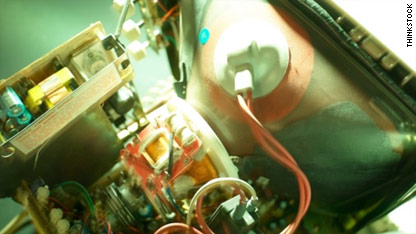Scammer
Banned

[video]http://cnn.com/video/?/video/tech/2011/01/24/feyerick.bomb.printing.cnn[/video]
-- The blast chamber looks like a giant meteor. Weighing 20 tons, it is made of 9-inch-thick slate gray steel.
It sits on rubber shock mounts which cushion the force of blasts that expand the walls of the massive sphere.
High explosives used to ignite nuclear weapons have been tested here. The device scientists are preparing to test today is simpler. It's made of a half-pound of high explosives and looks like a thin red pencil, wired to sensors that will record the shape and energy of the blast.
Scientists take their positions at the control switches, which look like leftovers from the Cold War era.
All the scientists know the drill and exactly what they're supposed to do. A bomb expert in a blue lab coat turns a key.
"We're at voltage," he says.
Our eyes jump from the laptop recording the blast to the red ignition button.
"Firing in 3... 2... 1."
His finger presses the button and we hear a thunderous boom from the chamber about 100 yards away.
The blast is invisible to the naked eye, but it's there, captured by high-speed cameras -- a flash in a few millionths of a second.
"No human eye can see that," says Jon Maienschein, who blows things up for a living.
Since 9/11, he and his team of scientists, physicists, bomb experts and engineers have recreated a number of devices used by terrorists.
"The explosives terrorists use, improvised explosives, are frankly mixtures that I didn't really expect would work," Maienschein says. "And so it's been eye-opening to us what actually will explode when you put it together."
The bomb blast chamber, one of the largest in the world, is at Lawrence Livermore National Lab near San Francisco.
Here, scientists and experts of all kinds study everything there is to know about explosives, assessing the overall threat and figuring out ways to control the damage.
"Their job in many cases is to think about what could happen, what could be done. How do you 'Red-Team,' we call it, the terrorists -- beat them at their own game," says Bruce Goodwin, who heads up defense and nuclear weapons at Livermore.
"An ounce of high explosives would ruin your whole day," he says knowingly.
The Lawrence Livermore National lab has analyzed the threat to airliners, testing explosives similar to those used by the underwear bomber, who tried to detonate plastic explosives or PETN onboard a commercial jetliner making its landing in Detroit on Christmas Day 2009.
"It would be interesting to see where that fellow got that from," Goodwin says.
He leaves it at that. Because he tests the viability of nuclear devices for the Defense Department, he knows a lot more than he can share.
Fingerprinting explosives, for example, helps scientists understand how they were made, the blast potential, even who may have put them together.
In October, the Yemen-based arm of the al Qaeda terrorist network claimed responsibility for a plot to send explosive devices on cargo planes bound for the United States.
Even before those printer cartridge bombs were sent from Yemen, scientists at Livermore were working on techniques to detect high explosives in people's cargo luggage and studying shock waves in order to design cargo containers that can contain the blast.
And it's that kind of science that policymakers and administration officials rely on when making their decisions.
Goodwin once walked into the blast chamber and said it smelled like a bakery. He soon understood why.
"Making high explosives in your kitchen -- we've been thinking about that for a very long time," he says. "And as a result we can advise on certain things that people should not be able to bring with them on the airplane, even if they look like, you know, you're getting ready for momma to make cookies."
